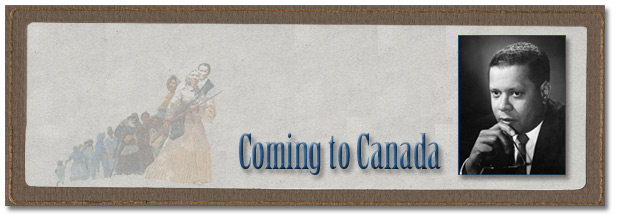
Table of Contents
Work at the Ontario Human Rights Commission | Black History in Canada | Canada’s First Human Rights Consulting Firm | Ombudsman of Ontario | Conclusion | Sources
Daniel Hill III applied to do graduate work at the University of Mexico and at the University of Toronto, vowing to move to whichever country would take him. He never heard back from the University of Mexico, but the University of Toronto accepted him into their master’s program in sociology, in the Faculty of Social Work. In 1950, Daniel Hill III left the United States and took a bus across the border to commence graduate studies at the University of Toronto.
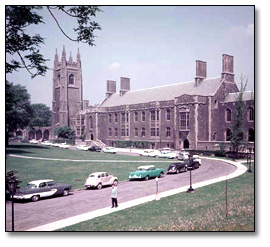
Click to see a larger image (111K)
Hart House, University of Toronto, 1953
Department of Travel and Publicity, Publicity Branch
Transparency
Reference Code: RG 65-35-3
Archives of Ontario, I0005555
Daniel Hill boarded in a rooming house on Pembroke Street when he first came to Toronto. He was struck to note that in comparison to Washington D.C., which had a population that was heavily Black, there were relatively few Blacks in Toronto. He used to say that it was common for him to walk to and from the University of Toronto and not encounter another Black person on the streets of Toronto.
After finishing his M. A. at the University of Toronto, Daniel Hill returned to the U.S. for one year to live with his parents in Washington D.C. and to teach sociology at the nearby Morgan State College in Baltimore. His plan was to spend just one year “back home”, and then to return to Canada, do his PhD in sociology, and stay in the new country for good.
While he was teaching at Morgan State College, Daniel Hill III met Donna Mae Bender, a recent graduate from Oberlin College in Ohio, who was working in Washington D.C. Born in South Dakota and raised in Chicago in a Republican family with conservative values about race and intermarriage, Donna had shaken off elements of her own background to become a civil rights activist. She was working as a secretary for Democratic Senator Herbert Lehman and in her free time, Donna was staging anti-segregation sit-in protests in Washington D.C., a rigidly segregated city.
A decade or more later, when she and Daniel had three children who were old enough to understand such conversations, she used to tell them that at the time that they became lovers, “Washington D.C. was so segregated that even federal government cafeterias denied Blacks and Whites the right to eat in the same room.”
Daniel and Donna married on June 8, 1953 in the chapel where Daniel Hill II was the minister, on the campus of Howard University in Washington D.C. Their plans to marry had caused shock waves among some circles of friends and families. Both Blacks and Whites objected to the news of their engagement, but Daniel and Donna held firm. Donna was loved and supported in her decision by her twin sister, Dorothy, but even Dorothy said to her sister wryly: “And where are you going to live? Sweden?”
When Daniel Hill and Donna Mae Bender married in 1953, they went entirely against accepted patterns in American and Canadian life at the time, given that he was Black and she, White. At the time, Americans were so hostile to the idea of interracial marriage that some states (such as Virginia) even outlawed them and prosecuted couples who married across the racial divide.
Just a few days after their wedding, Daniel and Donna drove in a 1946 Plymouth Sedan, which Daniel had picked up second hand for $300, to Canada. They honeymooned in Quebec City and then settled in Toronto.
Daniel and Donna’s decision caused stress among some relatives and friends, but they remained firm in their love and mutual devotion, and stayed together until Daniel’s death more than 50 years later.
The following clips from a hand held movie camera were taken of Daniel Hill III and Donna Bender during their wedding in Washington D.C. on June 8, 1953. Present are Daniel Hill II, May Edwards Hill, Doris Hill Cochran and Margaret Martin (sisters of Daniel Hill III), Dorothy Hampton (sister of Donna Bender). The young girl is Linda Martin, niece of Daniel Hill III.
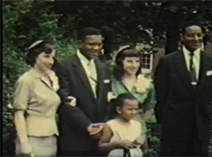
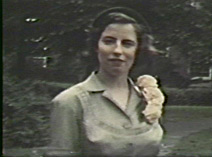
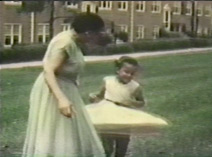
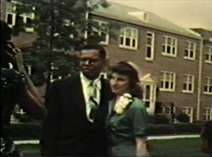
In Toronto, Daniel and Donna sought the more egalitarian society that they felt would welcome them as an interracial couple, but the sad truth was that initially they had difficulty persuading any Toronto landlord to rent them a room. Finally, after failing on numerous occasions to rent a flat together, they changed strategies. Donna left Daniel behind and took along a close friend of theirs-a White jazz musician named Don McFadyen - to pose as her husband. With her surrogate White husband on hand, she had no trouble renting a “bed-sitting” basement apartment (it had one room, a bathroom and a kitchen) on Bathurst Street, just south of Eglinton Avenue.
Speaking in an interview in 2007 with her son Lawrence, Donna Hill said: “The landlords watched Dan and me for six weeks or so and decided we weren't going to cause any horrible problems for them and finally let us sign a lease for about $80 a month plus parking.”
While Daniel settled into his PhD program at the University of Toronto, Donna Hill continued her civil rights activism, working for the Toronto Labour Committee for Human Rights to document instances of racial discrimination in Ontario. This work was part of a wider effort to persuade the Ontario government to enact more comprehensive anti-discrimination legislation.
Although Donna eventually set her own career aside to raise a family, her own interest in human rights and Black history continued. With some friends, she and Daniel co-founded the Ontario Black History Society in 1978, and worked for years to develop the organization. Donna also wrote A Black Man’s Toronto: The Reminiscences of Harry Gairey, 1914-1980. The 43-page booklet consists of a set of interviews with Harry Gairey, who was born in Jamaica in 1898 and moved to Toronto in 1914, shortly before his sixteenth birthday.
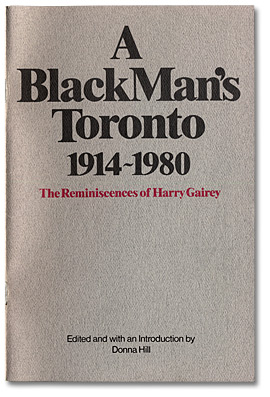
Cover from "A Black Man's Toronto, 1914-1980:
The Reminiscences of Harry Gairey",
edited and with an introduction by Donna Hill,
Multicultural History Society of Ontario, 1981
Courtesy of Lawrence Hill
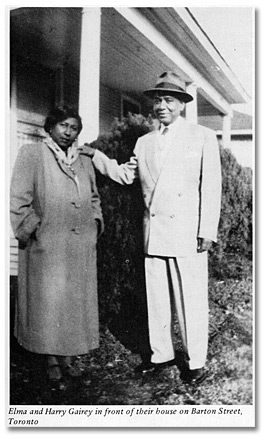
Click to see a larger image (159K)
Page 23 from “A Black Man’s Toronto, 1914-1980:
The Reminiscences of Harry Gairey”, edited and
with an introduction by Donna Hill,
Multicultural History Society of Ontario, 1981
Courtesy of Lawrence Hill
|
“The recollections of Harry Gairey, a senior statesman of the Toronto Black Community, do much to extend our history beyond its traditional boundaries. During our lengthy interviews he covered the experience of Black immigrants from the early 1900s to the present: the development of their community, the relationship between Canadian-born Blacks and immigrants; immigration legislation and policy; and the kind of discriminatory treatment Blacks encountered in their daily life.... My acquaintance with Harry Gairey began in 1953, when I was executive secretary of the Toronto Labour Committee for Human Rights. I had been invited to speak about racial discrimination at a meeting of the Toronto local of the Brotherhood of Sleeping Car Porters. Harry Gairey attended that meeting and later asked me to work with the Negro Citizenship Association in its struggle to change Canada’s discriminatory immigration policies. He came to my office again with information leading to one of the first federal Fair Employment Practices cases, a case which had nothing to do with Blacks but concerned a Japanese medical student whose application for a summer job as a CPR cook had been rejected. My friendship with Harry began, then, about forty years after he settled in Toronto. Harry had emigrated from Cuba just before the First World War, a boy of sixteen. He had faced no problem with immigration, but other forms of discrimination existed – there were few jobs he could hope for. Harry remembers well the era when Black people preferred to be called “coloured,” and when there were so few “coloured people” in Toronto that they all knew each other” Excerpt from introduction in “A Black Man’s Toronto, 1914-1980: |
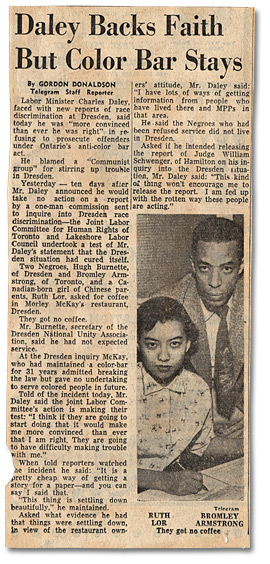
Click to see a larger image (372K)
Clipping from the Toronto Telegram,
"Daley Backs Faith But Color
Bar Stays", October 30, 1954
Daniel G. Hill fonds
Reference Code: F 2130-8-0-1
Archives of Ontario
Reprinted with the permission of
Sun Media Corporation
The newspaper clippings to the right and below relate to the efforts of the Toronto Labour Committee for Human Rights, for which Donna Hill worked, to prove that discrimination existed in Ontario and to press for firmer anti-discrimination legislation.
The clipping from the Toronto Daily Star below refers to Sid Blum, who began working at the Toronto Labour Committee for Human Rights shortly after Donna Hill resigned to start a family.
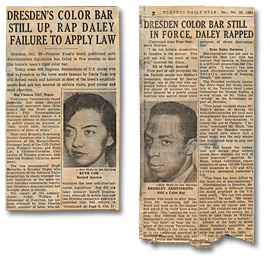
Click to see a larger image (145K)
Clipping from the Toronto Daily Star,
"Dresden’s Color Bar Still Up, Rap Daley
Failure to Apply Law", October 30, 1954
Daniel G. Hill fonds
Reference Code: F 2130-8-0-1
Archives of Ontario
Used with the permission of the Toronto Star Archives.